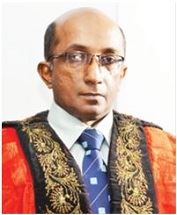|


By Eng. Prof. T. M. Pallewatta,
Int. PEng., CEng., FIE(SL), FIAE(SL)
President, IESL, 2018/2019
Senior Professor in Civil Engineering, Department of Civil Engineering, OUSL
My Dear Fellow Engineers,
The first time I got in touch with you through the "President's Corner" of the SLEN, I conveyed to you, five on-going objectives that need to be strived upon by the IESL for the betterment of our chosen profession of Engineering. If you could recall, you will remember that the first objective is to gear IESL for the implementation of the Engineering Council Act. This objective has been largely achieved through close collaboration with IESL by our members appointed to the Engineering Council of Sri Lanka (ECSL). As you have been informed, IESL Council has approved to bear the cost of first annual registration at the ECSL through IESL funds, for all eligible members under the categories of 'Chartered Engineer', 'Associate Engineer' and 'Affiliate Engineer'.
The second objective is to assist in the development of Engineering Education in Sri Lanka to current international standards. Throughout past several years, IESL has endeavoured significantly in this area by entering into Washington and Sydney Accords of the International Engineering Alliance (IEA) as the signatory for Accreditation purposes in the jurisdiction of Sri Lanka. To further this extremely important objective, the Council recently decided that a "National Policy on Engineering Education" needs to be formulated. At the last Council sitting the Council appointed a sub committee on an approved Terms of Reference (ToR). In this context we must first get ourselves acquainted with the history of Engineering education in Sri Lanka.
Engineering education in Sri Lanka dates back to 19th century not as engineering but as technical education. The establishment of Technical School in Colombo in 1893 was the starting point of engineering education in the country. In 1906 this organization was renamed as Ceylon Technical College (CTC) to receive in 1942, provisional recognition from the University of London to prepare students for a degree in Engineering.
When the University of Ceylon was established in 1942, a separate engineering college was not established as external degree course in engineering was available through the CTC. After ceasession of the collaboration between the CTC and the University of London in 1949, University of Ceylon was compelled to establish an engineering faculty by 1950 and the first BSc in engineering was awarded in 1953.
In 1952 the University of Ceylon was relocated to Peradeniya from Colombo, thereafter known as the University of Ceylon, Peradeniya. However, the engineering faculty was not moved to Peradeniya until the new engineering faculty complex was completed in 1964. Before the advent of Technical College at Katubedda, Moratuwa in 1972, the Faculty of Engineering of the University of Ceylon, Peradeniya was the sole engineering education facility in Sri Lanka. In 1978 the Technical College at Katubedda was renamed as University of Moratuwa, becoming the second university with a Faculty of Engineering. Established in 1980 the Open University of Sri Lanka cradled the third Faculty of Engineering utilizing open and distance mode of education delivery. Then the Engineering faculty of the University of Ruhuna established in 1999 further expanded the opportunities to study engineering, becoming the fourth faculty of engineering in Sri Lanka. As of the present, these four University Engineering Faculties are geared to produce in excess of two thousand Engineers per year. It is a known fact that the country is unable to gainfully employ these highly qualified professionals as many have already migrated or are planning to migrate to other countries. The question I would like you to ponder here is; 'Is this, the national contribution we expect from brilliant children of this land raised by their parents through love and dedication, surmounting umpteen hardships and who are totally educated through free education system with public funds?'
Recent surge in establishing engineering faculties in the national universities has resulted in three more engineering faculties being established in quick succession, with another two in the pipeline. Coupled with an abundant influx of private institutions, bent on profit, offering various forms of academic qualifications in engineering, with dismal pre-qualifications and highly questionable quality standards, the future of Engineering and Engineers in Sri Lanka looks really bleak indeed. This is the second question I would like to pose to you; 'Keeping aside your personal biases, is this, what you would want your esteemed profession to become, in the future of this country?'
When I was reading for my degree as an undergraduate, varied opportunities were available for engineering graduates to get involved in national development, where major projects were handled by government institutions. As budding engineers, we were longing to get into the thick of the actions after graduation. With successive governments vigorously shedding state entrepreneurship and going for third party contracts due to various reasons, opportunities for gainful employment by young engineers diminished. This situation is amply portrayed today, by engineers obtaining secondary qualifications and deviating from engineering in their employment. In this context, the government has more responsibility in gainfully employing graduate engineers for the benefit of the country than producing more and more under-employable engineering graduates, with state funds.
It is stemming from these thoughts, that the Council resolved that there should be a robust policy on Engineering Education for Sri Lanka. Such a policy deliberated and developed by the Institution of Engineers, Sri Lanka, the Apex body on Engineering to the Nation, would be a guiding beacon to the people and undeniable assistance to policy makers and legislators at national level.
May I take this opportunity to wish you 'Subha Aluth Awuruddak Wewa'.
Eng. Prof. T. M. Pallewatta,
Int. PEng., CEng., FIE(SL), FIAE(SL)
President of the IESL, 2018/2019
Senior Professor in Civil Engineering,
Department of Civil Engineering,
OUSL
|